The Huawei Mate 9 Review
by Matt Humrick on January 27, 2017 7:00 AM ESTGPU Performance
The Mate 9 is the first device we’ve tested using ARM’s new Bifrost GPU architecture. Like the Mali-T880MP4 Midgard GPU in the Mate 8’s Kirin 950 SoC, the Mate 9’s Mali-G71MP8 Bifrost GPU processes 1 pixel per clock per core and up to 12 FP32 FMAs per core; however, the Mate 9’s Kirin 960 SoC doubles the number of GPU cores, giving it a significant advantage over the Mate 8 in both ALU and texturing throughput and making it the first Huawei flagship phone with a flagship caliber GPU.
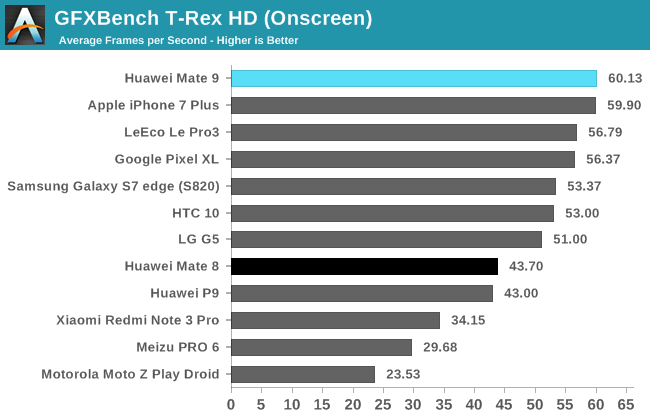
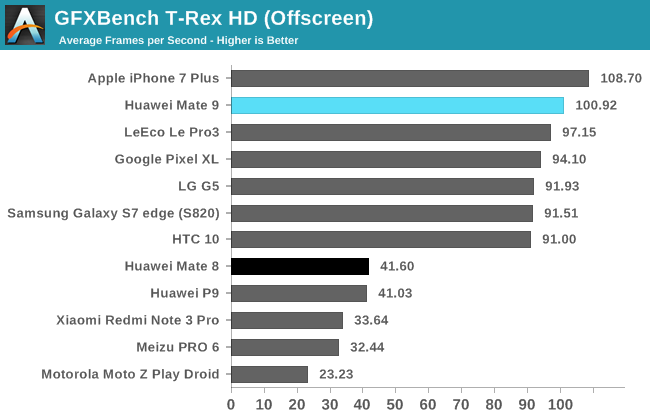
Flagship phones have been hitting the 60fps V-Sync limit in the older OpenGL ES 2.0-based GFXBench T-Rex game simulation for a while, but we’re now starting to see some phones averaging 60fps over the duration of the test, including the iPhone 7 Plus and Mate 9. Both of these phones have 1080p displays, which gives them an advantage over some of the other flagships with 1440p displays in the onscreen test, although they both maintain their advantage when running offscreen at a fixed 1080p resolution (but not limited by V-Sync). Throughput scaling based on core count should give the Mate 9 a 2x advantage over the Mate 8. In fact, the Mate 9 does a little better than this, outpacing the older model by 2.43x thanks to Bifrost’s microarchitecture improvements. The Mate 9’s Mali-G71MP8 even outperforms Qualcomm’s Adreno 530 GPU by a very small amount.
When running the original GFXBench Manhattan test, which uses an OpenGL ES 3.0 game engine, the Mate 9 remains competitive with phones using a Snapdragon 820 SoC. It’s still faster in the onscreen test due to its 1080p resolution, and essentially pulls even in the offscreen test.
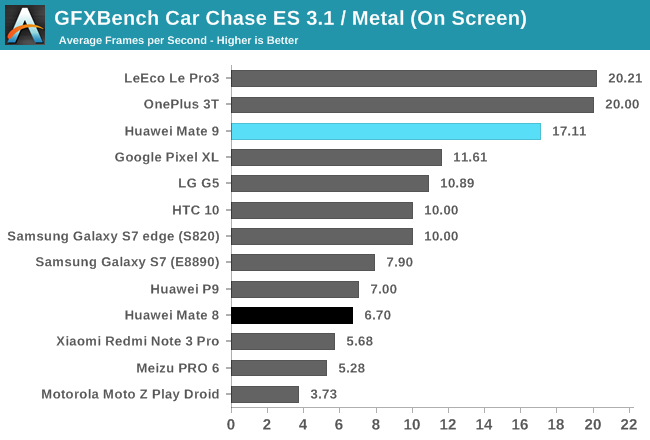

The GFXBench Car Chase game simulation uses a more modern rendering pipeline and the latest features, including tessellation, found in OpenGL ES 3.1 plus Android Extension Pack (AEP). Like many current games, it stresses ALU performance to deliver advanced effects.
Looking at the offscreen results, the Mate 9 is about 2.5x faster than the Mate 8 and P9, with performance scaling beyond the difference in core count once again. Perhaps the biggest change between ARM’s Midgard and Bifrost architectures is the move away from shader cores that use an SIMD ISA and rely on Instruction Level Parallelism (ILP) to shader cores with a scalar ISA that rely on Thread Level Parallelism (TLP). To fully utilize a shader core, Midgard needs to execute 4 instructions in parallel, which is not easy to do for a number of reasons. By moving to a scalar ISA, Bifrost can use TLP to increase shader core utilization, which is much easier to do with modern game engines and high-resolution displays.
The Mate 9 and its Mali-G71MP8 GPU also finish just ahead of the Mali-T880MP12 GPU in the Galaxy S7’s Exynos 8890 SoC, with the former’s architectural improvements and frequency advantage (the S7’s GPU runs at up to 650MHz) overcoming the deficit from using 4 fewer cores; however, it falls behind the phones using a Snapdragon 820/821 SoC, whose Adreno 530 GPU delivers better ALU performance. The LeEco Le Pro3, OnePlus 3T, and Pixel XL all use a newer GPU driver, which allows them to pull ahead of the other Snapdragon 820 phones.
In the onscreen test, the Le Pro3, OnePlus 3T, and Mate 9 lead the pack because they have fewer pixels to render.
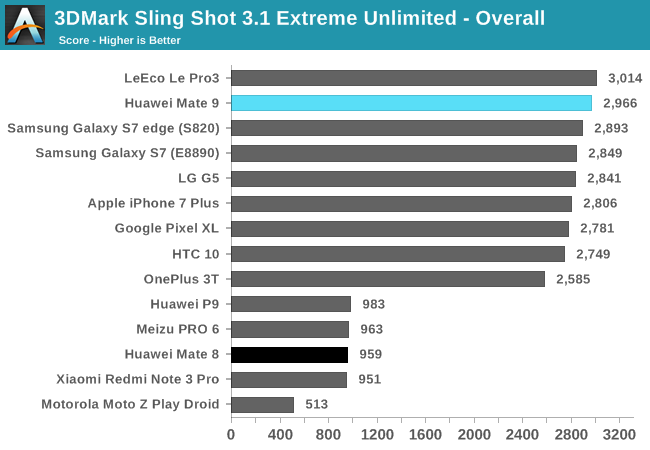
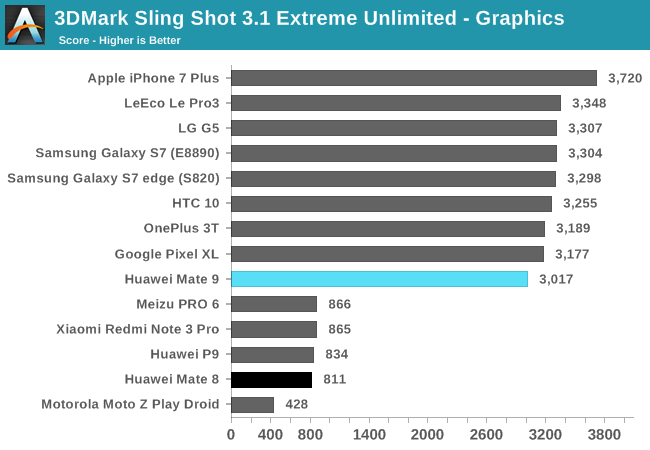
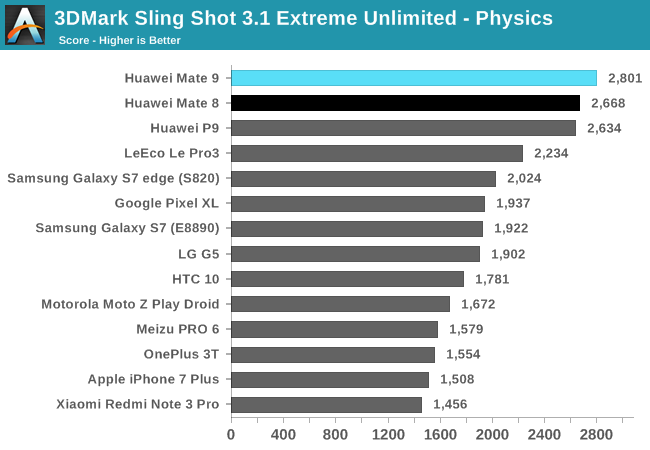
3DMark Sling Shot Extreme uses either OpenGL ES 3.1 on Android or Metal on iOS and stresses the GPU and memory subsystems by rendering offscreen at 1440p (instead of 1080p like our other tests).
Most of the current generation flagship phones perform well in this test, with only a 17% performance spread between the LeEco Le Pro3 and the OnePlus 3T based on the overall score. Looking specifically at graphics performance, the Mate 9 sits in the flagship group at the top of the chart, while the Mate 8 and P9 find themselves among the mid-range phones. ARM’s new Bifrost architecture does particularly well with this workload, showing an 86% improvement over the Midgard GPU architecture in the Mate 8 after applying a 2x scale factor to simulate the difference in core count.
The Physics test runs on the CPU and is heavily influenced by memory controller performance. The Kirin 950/955/960 SoCs in Huawei’s phones handle this specific workload the best, outpacing the Snapdragon 821 in the Le Pro3 by 25%.


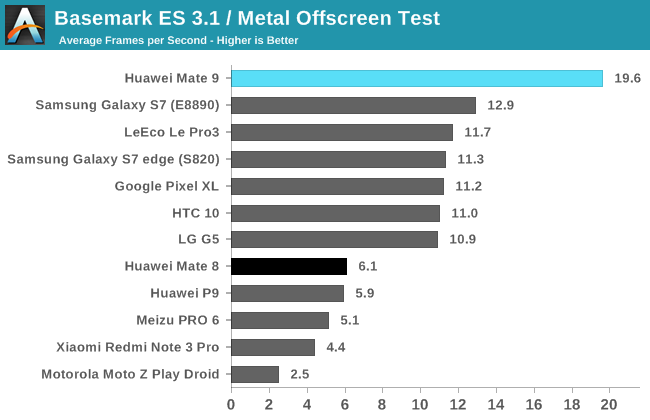
The demanding Basemark ES 3.1 game simulation uses either OpenGL ES 3.1 on Android or Metal on iOS. It includes a number of post-processing, particle, and lighting effects, but does not include tessellation like GFXBench 4.0 Car Chase.
The iPhone 7 Plus takes advantage of Apple’s Metal graphics API, which dramatically reduces driver overhead when issuing draw calls, to pull ahead of the Android phones that are still using OpenGL. Recent Android devices, including the Mate 9, support Vulkan, a new graphics API that brings similar benefits as Apple’s Metal, but we will not see benchmark support for it until later this year.
The Mate 9 does extremely well in this test, outpacing the Galaxy S7 and its Mali-T880MP12 GPU by 52% and the Le Pro3’s Adreno 530 GPU by 68%. It’s also 3.2x faster than the Mate 8, with Bifrost showing a 61% advantage over Midgard (after applying a 2x scale factor to simulate the difference in core count).
Huawei finally delivered a flagship phone with a flagship-class GPU. The Mate 9 and its Kirin 960 SoC show excellent peak performance in our tests, making it competitive with current flagship phones and SoCs.
ARM’s new Bifrost GPU architecture is also big improvement over Midgard. While game simulation tests are too high level to correlate performance gains with specific changes, it appears the switch to a scalar ISA that relies on TLP rather than ILP was the right choice, leading to higher shader core utilization in modern game engines.










84 Comments
View All Comments
lolipopman - Saturday, January 28, 2017 - link
No mention of thermal throttling, great work, guys!Meteor2 - Saturday, January 28, 2017 - link
?? Read the review more carefully.s.yu - Saturday, January 28, 2017 - link
At least they didn't send the Samsung copycat version over for the review.Shadowmaster625 - Saturday, January 28, 2017 - link
And yet another android SoC gets eaten by apple.cokata1 - Sunday, January 29, 2017 - link
The Mediatek X30 should be a very interesting SoC to take a closer look at. I hope Anandtech does a deep dive for it. 2X A73 @ 2.8Ghz with 4x A53s and 4x A35s all on 10nm process. This should be the first Mediatek SoC that is competitive with the rest when it comes to power/watt, and we will see the A35 for the first time.thek - Sunday, January 29, 2017 - link
Hey look this website isn't dead..UtilityMax - Monday, January 30, 2017 - link
Are you guys also going to review the Huawei Mediapad M3? That was basically the only top-major-vendor brand new Android tablet introduced in the USA in 2016.aryonoco - Monday, January 30, 2017 - link
Anandtech reviews are completely losing sight of what's important.There is a whole section on "Software", where multiple paragraphs are spent talking about what the icons looks like and what this specific highlight color is. And yet there is no mention of stuff that actually matters: What Android security patch level is this thing running? Has the manufacturer committed to providing security updates on a timely basis? For how long?
What's the point of spending $600 on a device that comes with root exploits out of the box?
Now tell me, is prompt security updates not worth even a single mention in a product review?
Matt Humrick - Tuesday, January 31, 2017 - link
I discussed Huawei's update policy in our Honor 8 review, which I linked to in the first paragraph of the software section. As of today, the Mate 9 has the November security patch. Currently, I would say Huawei is about average for releasing security updates and a little below average for releasing OS updates.akdj - Wednesday, February 1, 2017 - link
Matt,I just wanted to drop a quick thanks and throw some shade your way for both a job well done and continued efforts in spite of ridiculous, incessant and from the same family of foolishness ubiquitous throughout technology review and rumor sites, forums and social media.
I'm not alone and I'm sure most here recognize just the recovery time to 'process' sites, sounds - products and future technology gleaned from another CES - which ended just three weeks ago! Not to mention 'Vegas' recovery in and of itself, travel and catch up with, what I'm sure each of you have, that 'other life'! It's obligations, responsibilities and a few hours of sleep --
Not to mention constant communications with different OEMs about product, shipping and scheduling and doing so with the offering of a completely free website run by enthusiasts who possess more knowledge in a broader expanse of tech hard and software than most of us readers and typical but focused enthusiasts interested in other areas and aspects of technology.
IMHO, the job you do for the millions each of you makes yearly;) - is nothing less than greatly appreciated by an exponential percentage that'll ever take the time to post, even register with your site - IOW; you've a huge percentage of 'happy' and 'return' visitors vs. the usually humorous and ignorance displayed by a few in your response and comments. I've long since given up responding to each bozo I disagree with, reserving my attacks for those deserving and spreading unusual, over the top BS about product to perspective users, buyers or legitimate queries
You still host a site second to not a single site when it comes to in depth, well written and researched/combined with real world usage, avoiding time to press pressure... providing amazing, compelling reviews filled with detailed objective and subjective data by authors with obvious enthusiasm for technology and it's constant march in to the future inevitably offering faster, more reliable, durable 'better' product choices every day, week, month, and years that go by...
Some'll still be feeding spiders in mom's basement, drinking Mt Dew with a serious lack of 'outdoor time' - @ 45 years old behind the anonymity of their keyboards waking daily with a single goal in mind. Belittle others, demand from anyone but themselves, and magnify their miserable (yet easily changed, bettered, and enjoyed...) existence online.
As anonymous ghosts empowered by their ability to hide in mom's basement, enjoying a false sense of security while feeding said spider;)
Take care, Happy New Year and hopefully you've had the opportunity to recover from CES, transfer your stills and video and 'thoughts/notes' to the 'mainframe' - with a chance to unwind and debrief! As always, regardless of when the A10 'deep dive' is posted, an in depth essay on the architecture of the new SD-835 or your review of the new MacBook Pro's 15" fully upgraded Touch Bar hits - whether beaten by your ten pages on Dell's XPS 15" - I'll be here, I'll read and guaranteed, I'll enjoy your time, efforts and enthusiasm for a job VERY Well Done
Thanks
Jeremy